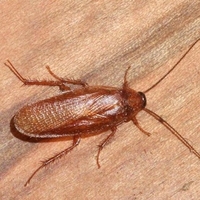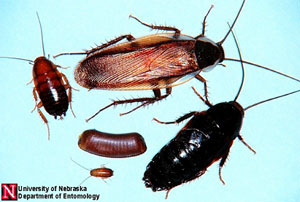 How to Identify Wood Cockroaches
How to Identify Wood Cockroaches
Is the roach as large as your index finger? Is it reddish at the head and almost black everywhere else and without wings (female)? Or is it light brown, a good flyer with wings longer than its body, and attracted to lights at night (male)? If so, you’re probably looking at a wood cockroach.
It is very important to know which species of cockroach you’re dealing with since their habits and food preferences vary greatly.
Roaches (cockroaches) are among the most important pests residentially and commercially.
Their mere presence is a nuisance and they can be carriers of many common diseases.
Where do Wood Cockroaches Come From?
- You are really living in their (the wood roach’s) neighborhood, whether you reside in Raleigh, Charlotte, Wilmington or a surrounding area.
- The wood roach lives in decaying organic material (mulch areas), fallen logs, stumps, etc.
- They are nocturnal which means they are active at night. During the night, they forage, crawl into weep holes, on buildings or up the outsides of the home or structure and get into the gutter and sometimes live there.
- The nymphs and adults are usually found outdoors beneath loose bark in wood piles, stumps, hollow trees and mulch piled around homes. Adults and nymphs are active from May to October. They overwinter as nymphs and mature in May and June.
- Males are good flyers; you may notice them around lights at night.
Where do You See Wood Roaches?
You will usually see the female roach on the bottom floor of the building, as well as den areas, garages, basements, storage sheds, decks, etc. They will frequently be brought into the house by hitching a ride on firewood.
The male wood roach will be seen around doorways and around outside lights.
Fortunately, wood roaches will not breed in the home because they require the moist environment outside, but can invade from the outside of the home or structure.
How do Wood Cockroaches Multiply?
Egg capsules are produced during the warm summer months and are deposited behind the loose bark of trees, fallen logs, stumps, and mulch placed beside the structure. Each egg capsule contains up to 32 eggs.
Ways to reduce the conditions that harbor and attract the wood roach:
- Remove leaf clutter near structure
- Remove brush piles from structure
- Remove old logs and stumps
- Move woodpiles 25 feet away from structure
- Seal gaps around doors and windows
- Repair foundation cracks
- Repair moisture-damaged wood inside and outside structure
- Repair foundation vents screens
- Clean debris from gutters and downspouts
- They feed on decaying organic material
- Repair all leaks in structure
- Seek professional assistance and a pest prevention plan
Economy Exterminators’ Pest Control Solutions program uses the 4-step approach to solve your wood roach pest problem:
- Our 1st step is the inspection of the property by a Raleigh, Charlotte or Wilmington customer service representative. It is very important to know the species involved and the severity of the pest problem.
- The 2nd step is the initial treatment by a customer service representative of all areas that the inspection revealed as critical areas. Economy Exterminators uses the newest and most effective materials to solve this pest problem fast for you. Critical areas usually include the outside areas, kitchen, storage areas, crawlspaces, and garages.
- The 3rd step is a 37-point inspection of your property to identify areas that allow easy access of the wood roach to your property by either direct access (cracks in the foundation) or by harborages or food sources that are attractive to this roach.
- The 4th step is an ongoing maintenance program, such as our Pest Control Solutions program, to prevent the next generation of roaches. The next generation comes from the egg capsules which are placed or glued by the female in protected areas. Preventative maintenance outside by chemical and non-chemical means is what is usually required to prevent the wood roach from gaining access to the inside of the structure.

 How to Identify Wood Cockroaches
How to Identify Wood Cockroaches



